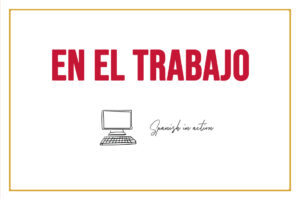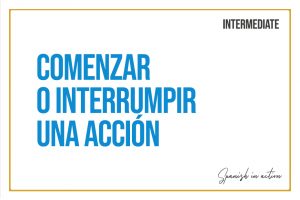It doesn’t matter if you think you have a bad memory. Many students say they don’t remember grammar classes from highschool. Of course you don’t! But when you restart studying again, you bring all you have in your memory step by step.It is a matter of time and practice.
If we talk about new vocabulary, there are circumstances and situations that will allow you to stick with some words. You know this intuitively.
In this article you will find different techniques to easily memorize new vocabulary while you learn Spanish.
1-Context
If you learn with context, your brain will associate a word with an image without effort. How can we create context? Gestures,mimics, colors, sounds, even intonation will help you with association.
It is very common in children’s language learning. Total Physical Response (TPR) is a method of teaching language or vocabulary concepts by using physical movement to react to verbal input. The process mimics the way that infants learn their first language, and it reduces student inhibitions and lowers stress. The purpose of TPR is to create a brain link between speech and action to boost language and vocabulary learning.
2-The space repetition technique.
Many learners swear by flashcard systems, which involve studying words or sentences in the language you’re learning on one side of a card with a translation or picture on the other.
Nowadays, people use apps like Memrise and Anki which show flashcards at specific intervals to optimise learning. This technique, known as spaced repetition, is based on observations by memory researcher Hermann Ebbinghaus, who noticed that we’re better at remembering information learned a few times over a longer period of time compared to many times within a short space of time. This means that we can learn more vocabulary with less effort, by spreading out our study sessions.
However, learning vocabulary is more complex than memorising a bunch of words. When we focus too much on flashcards, there’s a danger we’ll end up recognising lots of words without knowing how to use them in real life. Also, languages are about communication – spending too much time with your head in an app is boring and it sucks the soul out of learning. Finally, if you don’t dedicate enough time to engaging with the language in a real way by listening, reading and talking to native speakers, you’ll never learn how people actually talk.
3-Use the word.
The more you use your new words, the faster you’ll remember them. There are lots of different ways to put this into practice: you can build new sentences in your mind, write a few examples, or try throwing the words into a conversation when opportunity arises. Always be on the lookout for opportunities to bring your new words out of books and apps and into real life contexts.
Making your own takes a little more effort in the beginning, but it’s infinitely better to use words you have met in real contexts through listening, reading or conversations. This is because memory is highly context dependent – decades of research show that we remember information more easily when we associate it with the context we first learned it in. When you make your own sets with words you’ve already met, you can link them back to the original context and remember them much faster.
4-Learn how to use the word in a sentence.
There’s no point in learning lots of isolated words without knowing how to use them. Recording the whole sentence (or a short snippet if it’s too long) gives you information about the sentence structure so that you can build new sentences with your word. Learning sentences also helps you associate the word with the original context, giving you an extra memory boost.
As you can see, learning vocabulary is not difficult. We love our programs because lessons in Spanish Perfecto are designed to learn new vocabulary in real life situations, in a real context, and using it with the correct grammar structure.
See you!



